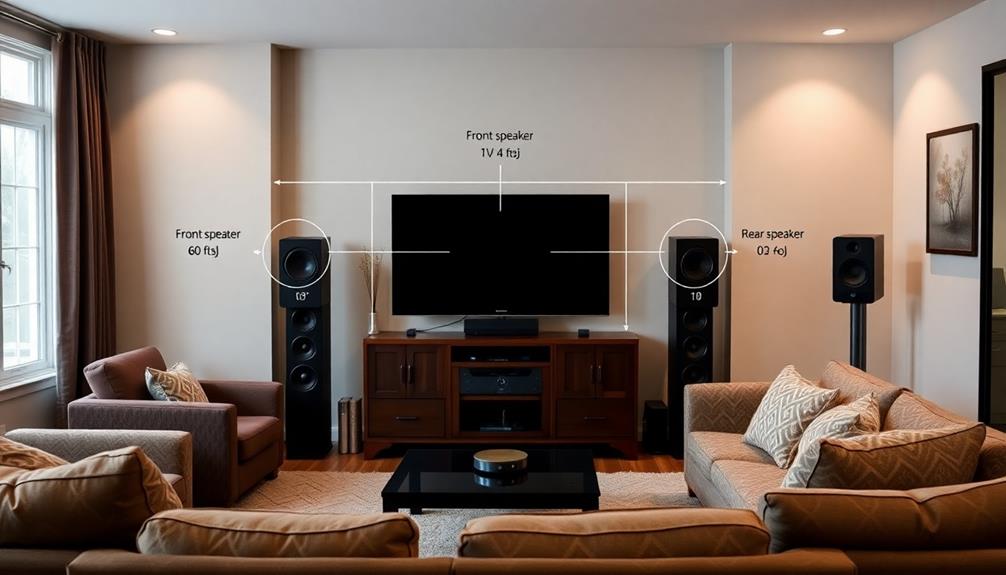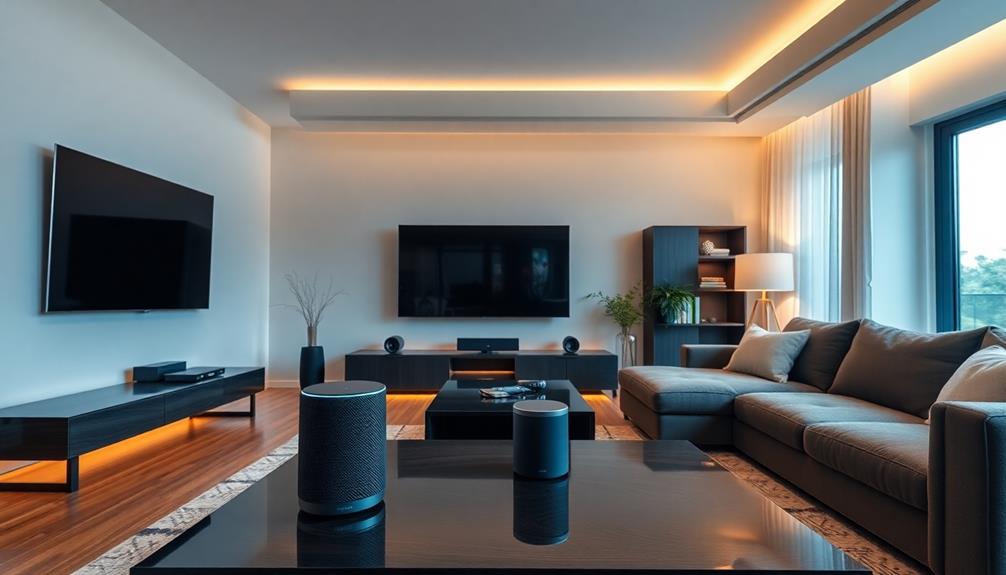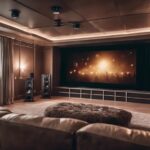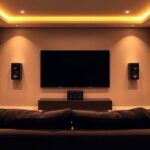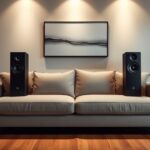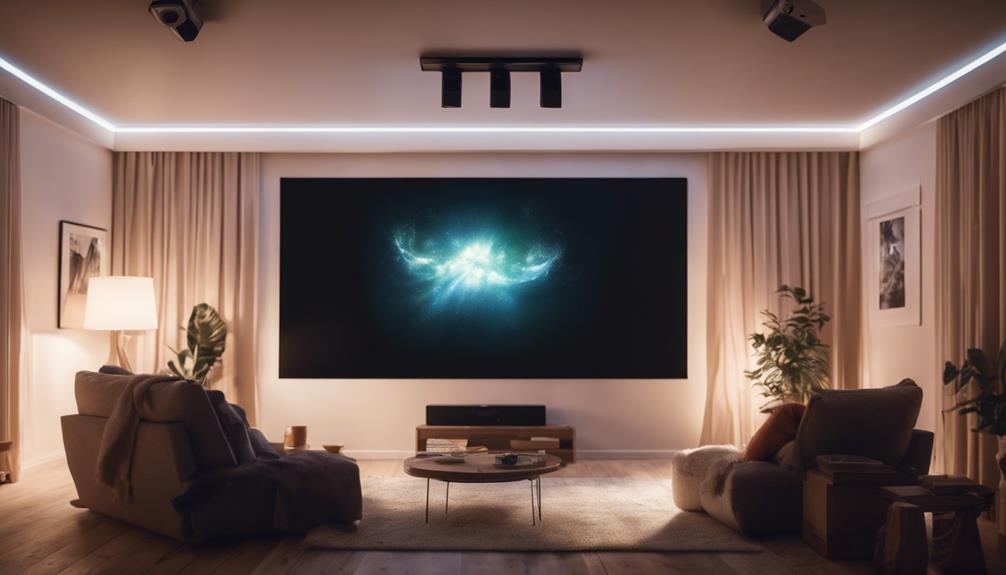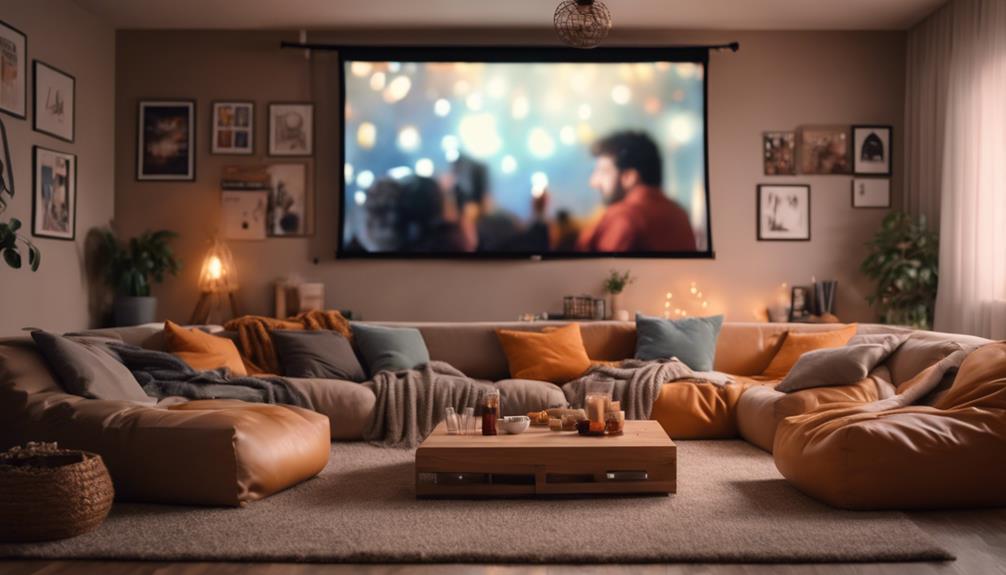To set up your surround sound effectively, focus on speaker placement for the best audio experience. Position front left and right speakers to form an equilateral triangle with your main seating. The center speaker should be at ear level to guarantee clear dialogue. Place surround speakers at ear level, ideally positioned 90-110 degrees from where you sit. For peak bass, try placing your subwoofer in a corner. Consider using acoustic treatments like curtains to reduce echoes. Adjusting these placements can dramatically enhance your audio immersion, and you'll discover even more techniques for a fantastic setup just ahead.
Key Takeaways
- Position front left and right speakers to create an equilateral triangle with the listening position for balanced sound.
- Place the center speaker at ear level and tilt it towards the listener for optimal dialogue clarity.
- Surround speakers should be at ear level, positioned 90-110 degrees from the listening area to enhance immersion.
- Use the subwoofer crawl technique to find the best corner placement for improved bass response.
- Incorporate acoustic treatments, like rugs and panels, to minimize echoes and improve overall sound quality.
Importance of Speaker Placement

When you place your speakers correctly, you can greatly enhance your audio experience. Proper speaker placement is essential for enjoying clear dialogue and realistic sound effects, like explosions and footsteps.
Start with your front left and right speakers; they should be spaced equally from the center speaker and your main listening position, forming an equilateral triangle. This setup guarantees balanced sound delivery, similar to how a projector's 4K resolution provides sharp images.
Next, focus on your surround speakers. Position them at ear level or slightly above to maximize immersion and direct sound toward you. This placement helps create a more engaging atmosphere while you watch movies or listen to music.
Don't overlook subwoofer placement, as it greatly impacts bass quality. Corners usually provide enhanced low-end punch, but you might need to experiment with locations to find the ideal bass response for your room.
Lastly, consider room acoustics. Adjustments in speaker positioning can minimize reflections and improve overall sound quality.
Front and Center Speakers

Positioning your front and center speakers correctly is vital for achieving an immersive audio experience. Start by ensuring your front left and right speakers form an equilateral triangle with your listening position. This setup guarantees ideal soundstage width and clarity. The center channel speaker plays an important role in dialogue clarity; place it directly above or below your TV screen, with the tweeter aligned at ear level for the best auditory experience.
To enhance sound quality, pull your front speakers away from walls by at least a few feet. This minimizes reflective sound quality that can distort your audio. Additionally, tilt the center channel speaker slightly towards your ears, directing sound where it's most needed.
Use familiar audio clips to evaluate and fine-tune the positioning of your speakers. Here's a quick reference table:
| Speaker Type | Positioning Tip | Purpose |
|---|---|---|
| Front Speakers | Form an equilateral triangle | Ideal soundstage width |
| Center Channel | Align tweeter at ear level | Enhance dialogue clarity |
| Front Speakers | Pull away from walls | Minimize reflective sound |
| Center Channel | Tilt towards listener | Direct sound for clarity |
Surround and Subwoofer Setup

After setting up your front and center speakers, the next step is to enhance your surround and subwoofer setup for a truly immersive audio experience.
For a 7.1 surround sound system, position your surround speakers at ear level to the left and right of your main listening area. Aim these speakers towards you to improve your surround sound experience. If possible, elevate them by 1-2 feet above ear level to further enhance audio quality.
Consider that just like home security systems, the arrangement of your audio equipment plays an essential role in overall performance.
Place your rear speakers behind you to maximize immersion.
Now, let's talk about subwoofer placement. The position of your subwoofer greatly affects bass performance. For a punchy low-end, try placing it in a corner. However, don't hesitate to experiment with different locations to achieve the best bass response.
A great technique is the subwoofer crawl—move the subwoofer around while playing bass-heavy content to find the best spot in the room.
Consider adding a second subwoofer for improved bass distribution, resulting in a more dynamic and even sound experience.
With careful speaker positioning and subwoofer placement, you'll elevate your home theater setup to new heights.
Acoustic Treatments for Sound

To achieve the best sound quality in your home theater, incorporating acoustic treatments is essential. Start by adding thick curtains and area rugs to your space. These soft furnishings absorb sound waves, reducing harsh reflections and echoes that can muddle your audio experience.
Additionally, take into account using essential oils like lavender or chamomile, which can promote relaxation and enhance your overall viewing experience through a calming atmosphere Aromatherapy can stimulate the limbic system.
You'll also want to think about specialized acoustic panels. Placing them strategically on walls can target specific frequencies, enhancing clarity and creating a more balanced listening environment.
Don't overlook the corners of your room; that's where low-frequency buildup often occurs. Implementing bass traps can help manage this accumulation, ensuring a smoother bass response and minimizing muddiness.
Additionally, utilize your receiver's room calibration software. This tool optimizes your speaker settings based on the room's unique acoustics, adjusting timing, output levels, and equalization for the best audio experience.
Getting Started With A/V Systems

When you're getting started with an A/V system, the first step is selecting the essential components like your display, receiver, and speakers.
Next, consider your room layout, as it can greatly impact how sound and visuals come together.
Selecting Essential Components
Selecting essential components for your A/V system is crucial for creating an immersive home theater experience. Start with a high-quality A/V receiver to manage your audio and video signals effectively. Next, invest in front speakers and a center channel speaker for balanced sound, as they deliver the majority of the audio and clear dialogue. A subwoofer is necessary for deep bass, enhancing your listening experience.
Here's a quick breakdown of the key components you'll need:
| Component | Purpose |
|---|---|
| Front Speakers | Handle majority of audio, create soundstage |
| Center Channel | Delivers clear dialogue |
| Subwoofer | Produces deep bass |
| Acoustic Treatments | Optimize sound quality, reduce reflections |
Don't overlook the importance of surround speakers to complete your surround sound system. They create that enveloping, cinematic experience. Finally, consider adding acoustic treatments, like area rugs or thick curtains, to improve sound quality by minimizing harsh reflections. With the right components in place, you're well on your way to achieving an incredible home theater setup.
Room Layout Considerations
Creating the ideal room layout for your A/V system can greatly enhance your viewing and listening experience. Start by analyzing the dimensions of your home theater room to determine the best screen size and speaker placement. Your seating position should maintain a direct line of sight to the screen while ensuring a balanced distance from the speakers, which is vital for superior audio performance.
For your speaker configuration, position the front speakers in an equilateral triangle formation with your main listening spot. This arrangement helps achieve the best sound clarity and stereo imaging. Surround speakers should ideally be placed at ear level or slightly above, positioned at 90-110 degrees from your seating position to create an enveloping surround sound experience.
Don't forget to evaluate room acoustics. Assess the presence of hard surfaces and furnishings that may affect sound quality. Incorporate sound-absorbing materials to minimize echoes and further enhance your listening environment.
Initial Setup Guidelines
After you've laid out your room for ideal audio and visual experiences, it's time to focus on the initial setup of your A/V system. Start by selecting a high-quality A/V receiver, which serves as the control hub for your home theater setup.
Make certain it supports your desired surround sound formats, like 5.1 or 7.1.
Next, invest in essential components: front speakers, surround speakers, a subwoofer, and a display device, whether an HDTV or projector.
Consider your room dimensions, as they impact speaker placement and seating arrangements for best viewing and listening.
Use proper cables and connectors to guarantee effective signal transmission, which is vital for maintaining sound quality and overall audio performance.
Once everything's in place, take advantage of the automatic calibration feature in your receiver.
This will enhance your speaker settings by adjusting timing, output level, and equalization to suit your specific room environment.
Types of Surround Sound Systems

When it comes to surround sound systems, you'll find a variety of configurations designed to enhance your audio experience.
Each speaker configuration offers unique benefits, whether you're setting up a simple home theater system or going for advanced setups like Dolby Atmos.
Here are a few popular types:
- 5.1 System: This classic configuration features five speakers and one subwoofer, including front channels for dialogue and ambient effects from the surround channels.
- 7.1 System: Building on the 5.1 setup, it adds two rear surround speakers for improved spatial audio perception.
- 9.1 or 11.1 Systems: These advanced formats incorporate height speakers, creating an even more immersive experience.
- Dolby Atmos: A cutting-edge option that allows for object-based audio, delivering sound that moves around you in three-dimensional space.
- Speaker Placement: Proper positioning of all speakers is essential for maximizing audio immersion and achieving a balanced soundstage.
Choosing the right surround sound system and understanding the speaker placement guidelines are key to achieving the best listening position for your space.
Speaker Placement Strategies

Getting your speaker placement right can make all the difference in achieving an immersive audio experience. Start by positioning your front left and right speakers to form an equilateral triangle with your listening position. This guarantees they're spaced equally apart from the center speaker, enhancing sound clarity.
Place the center speaker directly above or below your TV screen at ear level, around 30-50 inches high, to direct clear dialogue and sound effects toward you.
For surround speakers, aim to set them at ear level and position them 90-110 degrees from your main listening position. This angle helps create an enveloping soundfield.
If you're using a 7.1 system, place the rear surround speakers behind your listening area at ear level, while side surrounds should be slightly above ear level for ideal spatial audio.
Frequently Asked Questions
What Is the Best Way to Arrange Surround Sound Speakers?
To arrange surround sound speakers effectively, position the center speaker at ear level near your TV, place front speakers in an equilateral triangle with your listening spot, and position surround speakers slightly elevated for immersive audio.
What Is the 1 3 Rule for Speaker Placement?
Did you know that proper speaker placement can improve sound quality by up to 30%? The 1/3 Rule suggests positioning speakers one-third into the room, optimizing sound distribution and enhancing your listening experience considerably.
How Do I Position My Speakers Perfectly?
To position your speakers perfectly, place the center speaker at ear level, position left and right speakers equidistant from it, and guarantee surround speakers face you for an immersive experience. Experiment with subwoofer placement for ideal bass.
What Is the Best Way to Set up 5.1 Surround Sound Speakers?
Imagine settling in for a movie night. To set up your 5.1 surround sound speakers, place the center channel at ear level, position the front speakers equidistant, and arrange surrounds for immersive audio bliss.
Conclusion
In the end, the magic of surround sound lies in your speaker placement. By carefully positioning your speakers and considering your room's acoustics, you transform your space into an immersive audio experience. So, why settle for ordinary sound when you can create an enthralling atmosphere that'll make you feel like you're right in the middle of the action? Immerse yourself in your A/V setup with confidence, and let the symphony of sound envelop you in every movie and song.
